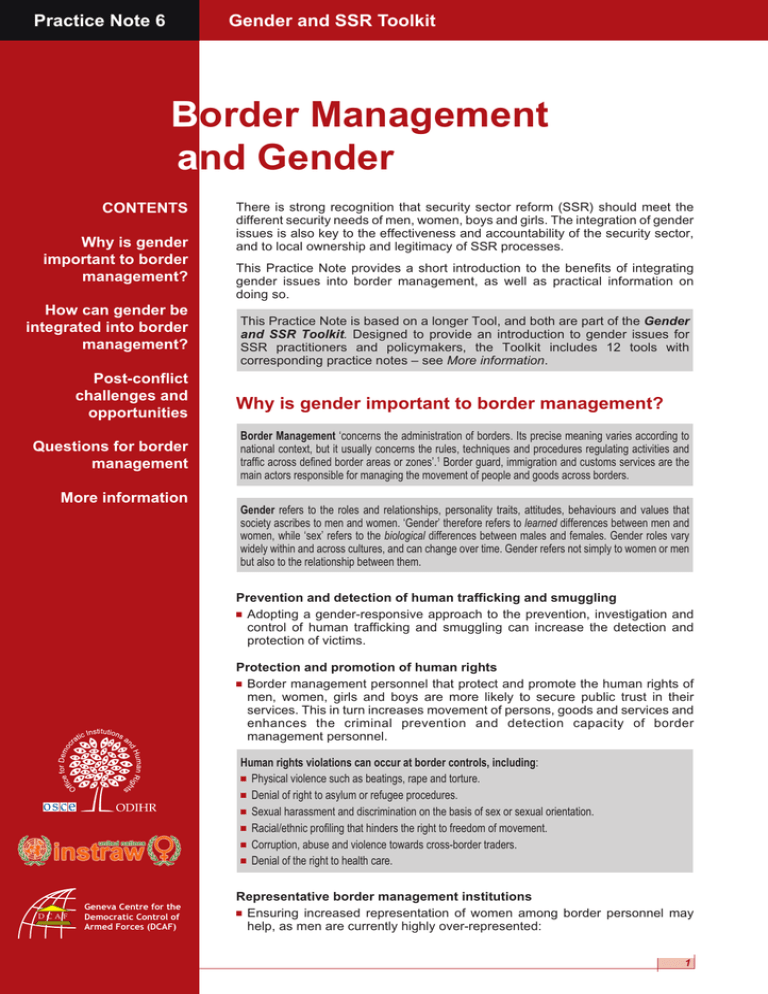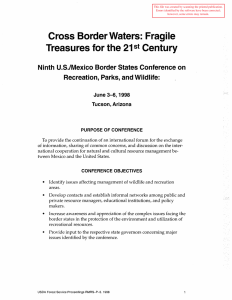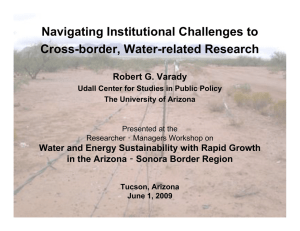B a order Management nd Gender
advertisement

Practice Note 6 Gender and SSR Toolkit Border Management and Gender CONTENTS Why is gender important to border management? How can gender be integrated into border management? Post-conflict challenges and opportunities Questions for border management More information There is strong recognition that security sector reform (SSR) should meet the different security needs of men, women, boys and girls. The integration of gender issues is also key to the effectiveness and accountability of the security sector, and to local ownership and legitimacy of SSR processes. This Practice Note provides a short introduction to the benefits of integrating gender issues into border management, as well as practical information on doing so. This Practice Note is based on a longer Tool, and both are part of the Gender and SSR Toolkit. Designed to provide an introduction to gender issues for SSR practitioners and policymakers, the Toolkit includes 12 tools with corresponding practice notes – see More information. Why is gender important to border management? Border Management ‘concerns the administration of borders. Its precise meaning varies according to national context, but it usually concerns the rules, techniques and procedures regulating activities and traffic across defined border areas or zones’.1 Border guard, immigration and customs services are the main actors responsible for managing the movement of people and goods across borders. Gender refers to the roles and relationships, personality traits, attitudes, behaviours and values that society ascribes to men and women. ‘Gender’ therefore refers to learned differences between men and women, while ‘sex’ refers to the biological differences between males and females. Gender roles vary widely within and across cultures, and can change over time. Gender refers not simply to women or men but also to the relationship between them. Prevention and detection of human trafficking and smuggling ■ Adopting a gender-responsive approach to the prevention, investigation and control of human trafficking and smuggling can increase the detection and protection of victims. Protection and promotion of human rights Border management personnel that protect and promote the human rights of men, women, girls and boys are more likely to secure public trust in their services. This in turn increases movement of persons, goods and services and enhances the criminal prevention and detection capacity of border management personnel. ■ Human rights violations can occur at border controls, including: ■ Physical violence such as beatings, rape and torture. ■ Denial of right to asylum or refugee procedures. ■ Sexual harassment and discrimination on the basis of sex or sexual orientation. ■ Racial/ethnic profiling that hinders the right to freedom of movement. ■ Corruption, abuse and violence towards cross-border traders. ■ Denial of the right to health care. DCAF Geneva Centre for the Democratic Control of Armed Forces (DCAF) Representative border management institutions Ensuring increased representation of women among border personnel may help, as men are currently highly over-represented: ■ 1 Box 1 Tips for gender-responsive procedures for female victims of human trafficking 1. It is unlikely a trafficked woman will respond to male investigators. Female investigators are far preferable in such cases, particularly for the victim’s sense of security. 2. A woman must be in attendance as a witness at all times. If no female personnel are available, a known and trusted women’s organisation representative can be an observer. 3. Separate the victim from the trafficker. 4. A female officer must conduct body and property searches. 5. Establish immediate contact with women’s organisations and victim advocates. 6. Ensure that physical and medical needs are met. - Ensure appropriate questioning, interviewing, body searches and follow-up procedures with respect to crimes such as human trafficking and smuggling. - Create more representative institutions that mirror the society they serve in terms of ethnicity, language, sex, religion, etc., which strengthens legitimacy and ‘normalises’ border environments. - Prevent human rights violations at the border such as sexual harassment, inappropriate body searches and the use of excessive force. Local ownership, civilian oversight and collaboration ■ Increasing the participation of key stakeholders, such as women’s organisations, in border management reform processes strengthens local ownership and civilian oversight. ■ Collaborating with women’s organisations, along with other civil society organisations, can yield critical local intelligence regarding criminal activity, expert policy advice and gender training expertise. Civil society organisations are also key referral Box 2 Ethical and safe interviews with trafficked people 2 1. Do no harm – treat each person as if the potential for harm is extreme until there is evidence to the contrary. 2. Know your subject and assess the risks before undertaking an interview. 3. Prepare appropriate legal, health, shelter, social support and security services referral information. 4. Adequately select and prepare interpreters. 5. Ensure anonymity and confidentiality. 6. Obtain informed consent from the respondent. 7. Listen to and respect each individual’s assessment of the situation and risks to her/his safety. 8. Do not re-traumatise anyone by asking questions intended to provoke an emotionally charged response. 9. Be prepared for emergency intervention. 10. Use information collected in a way that benefits individuals or advances the development of policies and interventions for trafficked people. 2 organisations for crime victims and provide complementary support services. Compliance with obligations under international laws and instruments Integrating gender into border management is necessary to comply with international and regional laws, instruments and norms concerning security and gender. Key instruments include: ■ The Beijing Declaration and Platform for Action (1995) ■ Protocol to Prevent, Suppress and Punish Trafficking in Persons, Especially Women and Children (The Palermo Protocol) (2000) For more information, please see the Toolkit’s Annex on International and Regional Laws and Instruments. How can gender be integrated into border management? Gather information ■ Collect, analyse and distribute accurate data on migration flows, human trafficking and human smuggling in order to improve border management policies and practices. At the minimum, disaggregate all data by sex, age, destination and purpose/intent of travel. Establish gender-sensitive policies, protocols and procedures ■ Develop gender-responsive policies, protocols and procedures (see Box 1) for identification, interviewing, body searches, investigation, detainment and other processes that take into account the different needs of women and men and differentiate between migration, human trafficking and human smuggling. ■ Establish clear codes of conduct; internal and external complaint, investigation and disciplinary procedures; and external conduct and review processes. ■ Make border management guidelines and policies openly available to the public and conduct regular consultations with various stakeholders on public opinion regarding perceived security threats and appropriate responses. ■ Implement gender-responsive and family-friendly human resources policies and practices, including sexual harassment policies. ■ As a critical step towards eliminating bribery and other corruption, review pay scales, staff development and other incentives for border management. Personnel are more likely to be responsive to reform measures if adequate pay and conditions of service are in place. Conduct gender training Develop gender training and capacity-building materials, specifically targeted at border management personnel and the unique challenges they face, including border guards, customs authorities and immigration service personnel. ■ Include women’s organisations in the development and delivery of gender training and other capacitybuilding initiatives. Box 4 The Border Action Network, with community organisations in the border states of the USA, have developed ‘Guidelines for Alternative Border Enforcement Policies and Practices’, to provide for accountability, human rights and community security. In June 2006, the Border Network for Human Rights in El Paso, Texas and Southern New Mexico submitted a Shadow Report to the Human Rights Committee that documents violations of human and civil rights in the US/Mexico border area. ■ Increase detection and protection of human trafficking victims ■ Make sure border management personnel have the capacity to recognise and identify human trafficking and distinguish it from smuggling, prostitution, voluntary work migration and other forms of crossborder movement: - Conduct thorough, informed surveillance and cross checks. - Recognise the different purposes and experiences of trafficking for women, men, girls and boys. - Build personnel capacity to provide adequate responses to victims of trafficking (see Box 2) – recognising vulnerabilities, resistance and needs – and familiarise personnel with standard operating procedures for referral and investigation. - Cooperate with women’s organisations and other non-governmental organisations to provide services to victims. Create more representative and participative border management institutions ■ Plan and target recruitment to attract more female applicants, including reviewing selection criteria, developing appropriate job descriptions, training recruitment officers on gender issues, revising recruitment materials and reviewing interview formats. Box 3 Female recruitment in Kosovo In the immediate aftermath of the war in Kosovo, efforts were made to recruit women as cadets in the new basic policing programme established by the OSCE. Courses in the first years recorded as high as 33% female graduates, but not everyone liked the job, some women quit when they had families, while others got better work offers elsewhere. Today, women represent close to 14% of the Kosovo Police personnel. The Kosovo Border and Boundary Police (BBPT) was formed later. In January 2007, of a total of 1,009 border police, 76 were women, and the General who heads the service is a woman. Civil society oversight 3 ■ ■ Appoint or promote qualified women to senior positions in border management (see Box 3). Increase the participation of local actors such as civil society orqanisations, including women’s groups, in the assessment, design, implementation and monitoring/evaluation of reform processes in order to increase transparency and local ownership (see Box 4). Monitor and evaluate Have an independent authority conduct ‘customer satisfaction’ surveys as part of monitoring. ■ Also available in Tool 6… - Tips for gender-responsive procedures - National referral mechanism model questionnaire - Tips for effective codes of conduct - Examples of gender training curicula for Kosovo Border and Boundary Police - Tips for increased recruitment, retention and advancement of female personnel Post-conflict challenges and opportunities Post-conflict border management reform may be an extremely sensitive process due to disputes over borders and control of borders by local armed groups. In many cases, border management systems will have to be built from scratch. Demilitarising and demining borders, preventing the illicit traffic of arms and humans, as well as ensuring the protection of refugees and displaced persons, are some of the immediate priorities of border management reform. Challenges for the integration of gender issues Borders remain contested areas and potentially hostile after conflict: an environment that is often deemed ‘too dangerous’ for women. ■ GBV against women and girls in environments with little oversight and near total impunity. ■ Increasing rates of human trafficking. ■ Priority is often given to general policing reform – reform of specialised policing, including border management, may be delayed and initial recruitment efforts to include women in security forces lose momentum. ■ 3 ? Questions for border management One of the best ways to identify entry points, strengths and weaknesses for incorporating gender issues into border management is to conduct an assessment. Below are sample questions on gender that are important to include in border management assessment, monitoring and evaluation processes. ■ ■ ■ ■ ■ ■ ■ ■ Have standard operating procedures for the referral of trafficking and smuggling victims been created? Are gender-responsive policies in place, such as codes of conduct and policies on sexual harassment and discrimination? Do border personnel reflect the society in terms of sex, ethnicity, religion, language, etc.? Are women and men equally employed at all levels of border management institutions? Are key stakeholders from government ministries and civil society, including women’s organisations, involved in assessment, planning, decision-making, and monitoring and evaluation processes for border management? Have border identification, interview and investigation processes been reviewed from a gender perspective? Have centralised registers for information gathering and exchange been created at border crossings? Is all data disaggregated by sex, age, and other relevant factors? Have border management personnel received accurate information and adequate and appropriate training on gender issues? Are border personnel adequately prepared to protect the rights and respond to the needs of trafficked and/or smuggled persons? More information Resources ILO – Human Trafficking and Forced Labour Exploitation: Guidance for Legislation and Law Enforcement, 2005. IOM – ‘Migration and Gender’, Essentials of Migration Management, 2007. IOM – Identification and Protection Schemes for Victims of Trafficking in Persons in Europe: Tools and Best Practices, 2005. OSCE – National Referral Mechanisms: Joining Efforts to Protect the Rights of Trafficked Persons: A Practical Handbook, 2004. UNODC – Toolkit to Combat Trafficking in Persons, 2006. WHO – Ethical and Safety Recommendations for Interviewing Trafficked Women, 2003. Organisations CLEEN Foundation – www.cleen.org Coalition Against Trafficking in Women – www.catwinternational.org Human Rights Watch – www.hrw.org 1 Hills, A.,’Towards a Rationality of Democratic Border Management’, Borders and Security Governance: Managing Borders in a Globalised World, (DCAF: Geneva), 2006, p. 33. 2 Adapted from: Zimmerman, C. and Watts, C., WHO Ethical and Safety Recommendations for Interviewing Trafficked Women, (WHO: Geneva), 2003. 4 ■ International Organization for Migration – www.iom.int No Border Network – www.noborder.org OSCE – www.osce.org UNIFEM – www.unifem.org Gender and SSR Toolkit 1. Security Sector Reform and Gender 2. Police Reform and Gender 3. Defence Reform and Gender 4. Justice Reform and Gender 5. Penal Reform and Gender 6. Border Management and Gender 7. Parliamentary Oversight of the Security Sector and Gender 8. National Security Policy-Making and Gender 9. Civil Society Oversight of the Security Sector and Gender 10. Private Military and Security Companies and Gender 11. SSR Assessment, Monitoring and Evaluation and Gender 12. Gender Training for Security Sector Personnel Annex on International and Regional Laws and Instruments Each of these Tools and Practice Notes are available from: www.dcaf.ch, www.un-instraw.org and www.osce.org/odihr. This Practice Note was prepared by Nadia Nieri of UNINSTRAW, based upon Tool 6 authored by Angela Mackay. 3 Border Network for Human Rights, ‘US/Mexico Border Report to the United States Human Rights Committee Regarding the United States Compliance with the International Covenant on Civil and Political Rights’, June 2006. http://www.borderaction.org © DCAF, OSCE/ODIHR, UN-INSTRAW, Gender and Security Sector Reform Toolkit. Eds. Megan Bastick and Kristin Valasek. Geneva, 2008. Opportunities for the integration of gender issues ■ There may be more political will among members of the international community, international organisations and newly-established governments to invest in reform processes. ■ Building up or reforming border management systems provides an opportunity to set targets for female recruitment and integrate gender issues into policy and protocol formation, operational programming, recruitment and training. ■ There may be an increased number of women available for employment within border services – including women heading and supporting households, and demobilised women with leadership and organisational skills.






